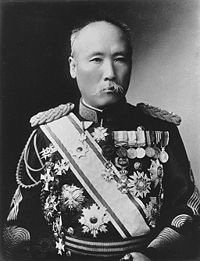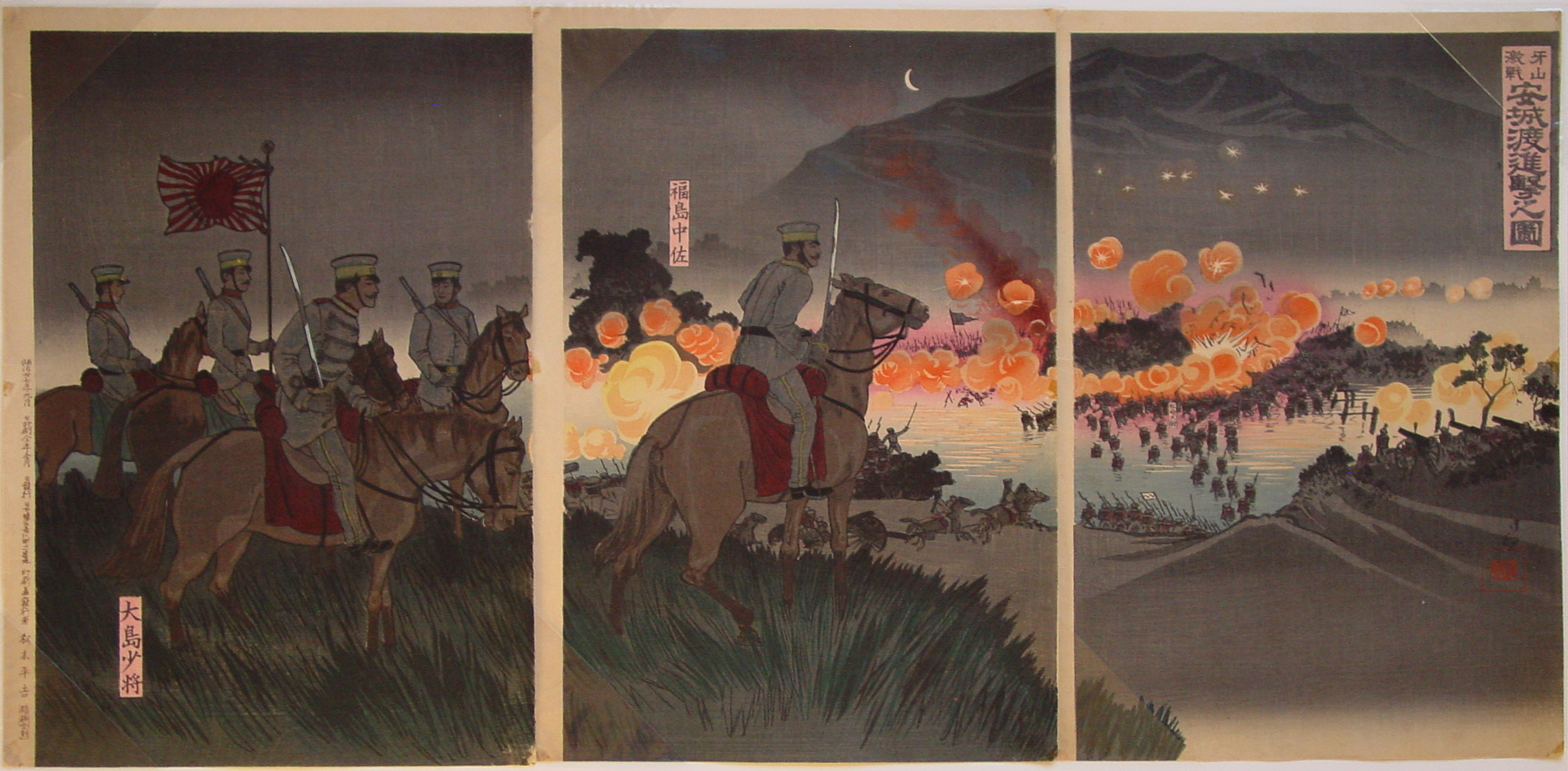About This Print
Source: The Sino-Japanese War, Nathan Chaiken, self-published, 1983, p. 64, illus. p. 127
The battle began shortly after midnight, and the crossing of the streama most courageous action, since the Japanese were quite unfamiliar withthe disposition of the land. The triptych shows Colonel Fukushima,acting as military adviser, Major-General Oshima Yoshimasa and, inmid-stream, Captain Matsuzaki soon to be killed, leading his men acrossthe water.
Kiyochika is at his very best in such scenes. His plays with night effect, shadows and illusions in ombres chinoises(puppet shadows), placed him in the forefront among artists engaged inthe war. Whereas his depictions of human beings remind us of woodenIndians – expressionless – and his caricatures simply humiliating, hisimpressionistic approach to light and shade is superb. As time wenton, he reached an unsurpassed level. During the Wei-Hai-Wei campaign,he brought out several woodcuts of breath-taking power.

A Japanese newspaper described his dress: "Over his military overcoat,he wore a fur coat, carried four saddle-bags made of skins, onesextant, a barometer, a map, a sword and a revolver. The weather wasfreezing, often below zero." Fukushima stated: "I rode daily aboutseven to nine hours, and sometimes up to twelve hours. Yet I never feltsick or tired. Only two nights did I have some headaches because of theflu, but I never even touched a drop of medication, trying to ride fastin order to sweat”.
In 1894, he was sent to the Korean front to assist and adviseMajor-General Oshima during the Seikan battle. During theRusso-Japanese war (1904-1905), he acted again as adviser, attached tothe Manchurian Army Headquarters. He was promoted Taisho (Marshal)after the war. His return to Japan was described by Basil HallChamberlain as follows: "In 1893, the whole nation went mad overColonel Fukushima's successful ride across Siberia; a perusal of thenewspaper of the time can alone give an idea of the popular frenzy..."(Konishi, Vol. XI, about woodcuts on Fukushima).
Source: Imperial Japan: The Art of the Meiji Era (1868-1912), FrederickBaekeland, Herbert F. Johnson Museum of Art, Cornell University, 1980, p. 130.
The Sino-Japanese War spurred Kiyochika to produce many triptychs, someof them outstanding. The best, like this example. Fierce Battle atAsan: The Anson Crossing Attack, are dramatic evocations of smallgroups of figures seen under special light conditions. Here the artistmakes the most dramatic contrasts between light and dark in a nightscene depicting an incident in Korea. He shows us five mountedofficers on a hill watching their troops cross a river while explodingartillery shells light up the farther shore.
On July 27, 1894, before the declaration of war, the Japanese army, ledby mixed brigade chief Major General Oshima Yoshimasa, fought anddefeated the Chinese at Asan during the crossing to Ansong. Here, incartouches with their names, we see two of the participants, Lt. Col.Fukushima (Fukushima Yasumasa, later a full general), on the right, andBrigadier General Oshima (Oshima Yoshimasa).
Print Details
| IHL Catalog | #96 |
| Title or Description | Illustration of the Attack at the Ansong Ford During the Fierce Battle at Asan Gazan gekisen Anjō no watashi shingeki no zu 牙山激戦 安城渡進撃之図 [牙山激戰安城渡進擊之圖] |
| Series | |
| Artist | Kiyochika Kobayashi (1847-1915) |
| Signature | Kiyochika 清親 |
| Seal | kiyo 清 and chika清 |
| Publication Date | September 1894 (Meiji 27) |
| Publisher |  [Marks: pub. ref. 029; seal not shown] |
| Edition | likely first edition |
| Carver |  |
| Impression | excellent |
| Colors | excellent |
| Condition | good - overall light toning; thinning at corners; small tape stains center of margins on each panel |
| Genre | ukiyo-e - senso-e (Sino-Japanese War) |
| Miscellaneous | |
| Format | vertical oban triptych |
| H x W Paper | 14 1/2 x 10 in. (36.8 x 25.4 cm) each sheet |
| H x W Image | |
| Literature | The Sino-Japanese War, Nathan Chaiken, self-published, 1983, p. 64, illus. p. 127s; Imperial Japan: The Art of the Meiji Era (1868-1912), FrederickBaekeland, Herbert F. Johnson Museum of Art, Cornell University, 1980, p. 130, fig. 69; Japanese Warrior Prints: 1646-1905, James King and Yariko Iwakiri, Hotei Publishing, 2007, p. 384. |
| Collections This Print | Smithsonian National Museum of Asian Art S2003.8.1368; The British Library BL Shelfmark 16126.d.3(28); Museum of Fine Arts, Boston 2000.241; Harvard University Museums 1944.5.19.1,.2,.3; Digital Collections of Keio University Libraries; Tokyo National Museum 列品番号: A-11933; Art Institute of Chicago 1995.206.26 |
4/17/2020


